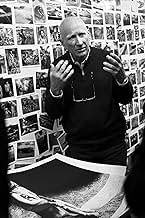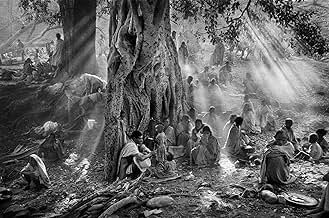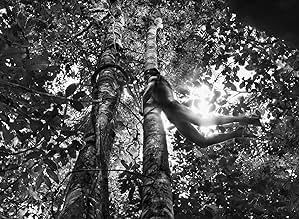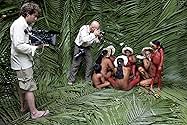IMDb RATING
8.4/10
25K
YOUR RATING
The life and work of photographer Sebastião Salgado, who has spent forty years documenting societies in hidden corners of the world.The life and work of photographer Sebastião Salgado, who has spent forty years documenting societies in hidden corners of the world.The life and work of photographer Sebastião Salgado, who has spent forty years documenting societies in hidden corners of the world.
- Directors
- Writers
- Stars
- Nominated for 1 Oscar
- 14 wins & 15 nominations total
- Directors
- Writers
- All cast & crew
- Production, box office & more at IMDbPro
Featured reviews
"We are a ferocious animal. We humans are terrible animals. Our history is a history of wars. It's an endless story, a tale of madness." – Sebastião Salgado
Directed by Wim Wenders and Juliano Ribeiro Salgado this documentary goes through the life of the photographer Sebastião Salgado, from its childhood times in Minas Gerais until his current role as an activist and founder of Instituto Terra. Not following the typical poetic and metaphorical style, and sometimes pretentious, that characterizes Wim so much, this documentary follows a simple line, however it's not a light viewing. In fact, it's hard, graphic and even chocking in some parts. Divided between the outside interpretations of Wim and Juliano, they reckon their perspectives were complemented with each other's, Juliano as son of Sebastião and Wim as the outside look, admirer of Salgado's work. But it's when Sebastião analyzes its photographs, the highlight of the film, that we realize who he really is and what he testified, transporting us into an incredible journey of anger, despair and hope.
Directed by Wim Wenders and Juliano Ribeiro Salgado this documentary goes through the life of the photographer Sebastião Salgado, from its childhood times in Minas Gerais until his current role as an activist and founder of Instituto Terra. Not following the typical poetic and metaphorical style, and sometimes pretentious, that characterizes Wim so much, this documentary follows a simple line, however it's not a light viewing. In fact, it's hard, graphic and even chocking in some parts. Divided between the outside interpretations of Wim and Juliano, they reckon their perspectives were complemented with each other's, Juliano as son of Sebastião and Wim as the outside look, admirer of Salgado's work. But it's when Sebastião analyzes its photographs, the highlight of the film, that we realize who he really is and what he testified, transporting us into an incredible journey of anger, despair and hope.
THE SALT OF THE EARTH
A documentary on the photographer, Sebastiao Salgado's passion for exposing worlds that are hidden from our view as well as the undercurrents of man's greed, violence and inhumanity - all through what co-director Wim Wenders explains is the process of " drawing with light." The other director is Juliano Ribeiro Salgado, the photographer's son. For many years, I have been beguiled by Salgado's black and white imagery, particularly as source material and inspiration for many of my own late 1980s pastels. His representations are stark and at the same time filled with an expanse of tones - from the deep darkness of coal to the blinding whites which shine with the force of incorporeality; a range of imperceptibly varied grays sandwiched in-between - all breathtakingly beautiful and often reduced to abstract patternings which are in danger of overtaking his subjects, but Salgado is a master at balancing form and content.
I was particularly moved by his photographs of the fierce deprivation that droughts and famine had wreaked on Sub- Saharan Africa - particularly Ethiopia. Because Salgado exposed situations that many people were not aware of, his photos drilled a space for perception into our consciousness. Salgado has traveled to over 100 countries - projects often lasted years and the resulting books include OTHER AMERICAS, WORKERS, SAHEL - THE END OF THE ROAD, MIGRATIONS, Africa, and most recently GENESIS - the book that became his respite after years away from his native environs, witnessing the globe's devastation, including chronicling the genocide in Rawanda and the Congo. By the late 1990's he was heartbroken: "We humans are a terrible animal; we are extremely violent Our history is a history of war; it's an endless story My soul was sick I no longer believed in anything, in any salvation for the human species." (Quotes from Kenneth Turan's review in LA Times.)
THE SALT OF THE EARTH invites us to enter Salgado's personal sphere; we meet his beloved wife Leila, the enduring relationship of his life, the editor of his photographs; the mother of Juliano and Rodrigo - the youngest born with Down syndrome; the compassion and love that unites the entire family in their own personal struggles with domesticity, and the enormous achievement of reclaiming the cattle ranch that was once Salgado's home near the town of Aimores in Brazil's state of Minas Gerais. Memories of the fecund greenery and waterfalls were incised into Sebastiao's childhood recollections and when he returned in the 1990's his homeland was an environmental disaster - dry and parched.
Salgado, his spirit quenched by regarding the pillage, and spoliation around the universe was re-invigorated by Leila's dream of planting a forest in Brazil starting with a few trees and "returning the property to its natural state of subtropical rainforest and in April 1998 they founded the Instituto Terra, an environmental organization which has now been declared a Private Natural Heritage Reserve, some 17,000 acres of deforested and badly eroded land have undergone a remarkable metamorphosis More than four million seedlings native to Brazil's Atlantic Forest have been raised in the institute's own nursery " * This resuscitation propelled Salgado to travel again focusing on the beauties of the planet, resulting in his latest book GENESIS. ( *About us -The Instituto Terra.) http://bit.ly/1JQQzvd
The documentary uses Salgado's majestic photographs interspersing them with site visits to previously unrecorded locations, including old color footage; using his voice and conversations to great effect. We get a sense of the quiet strength of this man, his commitment to justice and the deep suffering that his vision extracts with the lens of a camera. The plethora of interchangeable living beings moving about silhouetted against the background of clouds billowing in the infinite skies, underscore the brevity of time and existence. We are only here for a short interval and Salgado's output is a plea for respect, justice and accommodation among the men/women/animals and the frangible cosmos we all inhabit.
A documentary on the photographer, Sebastiao Salgado's passion for exposing worlds that are hidden from our view as well as the undercurrents of man's greed, violence and inhumanity - all through what co-director Wim Wenders explains is the process of " drawing with light." The other director is Juliano Ribeiro Salgado, the photographer's son. For many years, I have been beguiled by Salgado's black and white imagery, particularly as source material and inspiration for many of my own late 1980s pastels. His representations are stark and at the same time filled with an expanse of tones - from the deep darkness of coal to the blinding whites which shine with the force of incorporeality; a range of imperceptibly varied grays sandwiched in-between - all breathtakingly beautiful and often reduced to abstract patternings which are in danger of overtaking his subjects, but Salgado is a master at balancing form and content.
I was particularly moved by his photographs of the fierce deprivation that droughts and famine had wreaked on Sub- Saharan Africa - particularly Ethiopia. Because Salgado exposed situations that many people were not aware of, his photos drilled a space for perception into our consciousness. Salgado has traveled to over 100 countries - projects often lasted years and the resulting books include OTHER AMERICAS, WORKERS, SAHEL - THE END OF THE ROAD, MIGRATIONS, Africa, and most recently GENESIS - the book that became his respite after years away from his native environs, witnessing the globe's devastation, including chronicling the genocide in Rawanda and the Congo. By the late 1990's he was heartbroken: "We humans are a terrible animal; we are extremely violent Our history is a history of war; it's an endless story My soul was sick I no longer believed in anything, in any salvation for the human species." (Quotes from Kenneth Turan's review in LA Times.)
THE SALT OF THE EARTH invites us to enter Salgado's personal sphere; we meet his beloved wife Leila, the enduring relationship of his life, the editor of his photographs; the mother of Juliano and Rodrigo - the youngest born with Down syndrome; the compassion and love that unites the entire family in their own personal struggles with domesticity, and the enormous achievement of reclaiming the cattle ranch that was once Salgado's home near the town of Aimores in Brazil's state of Minas Gerais. Memories of the fecund greenery and waterfalls were incised into Sebastiao's childhood recollections and when he returned in the 1990's his homeland was an environmental disaster - dry and parched.
Salgado, his spirit quenched by regarding the pillage, and spoliation around the universe was re-invigorated by Leila's dream of planting a forest in Brazil starting with a few trees and "returning the property to its natural state of subtropical rainforest and in April 1998 they founded the Instituto Terra, an environmental organization which has now been declared a Private Natural Heritage Reserve, some 17,000 acres of deforested and badly eroded land have undergone a remarkable metamorphosis More than four million seedlings native to Brazil's Atlantic Forest have been raised in the institute's own nursery " * This resuscitation propelled Salgado to travel again focusing on the beauties of the planet, resulting in his latest book GENESIS. ( *About us -The Instituto Terra.) http://bit.ly/1JQQzvd
The documentary uses Salgado's majestic photographs interspersing them with site visits to previously unrecorded locations, including old color footage; using his voice and conversations to great effect. We get a sense of the quiet strength of this man, his commitment to justice and the deep suffering that his vision extracts with the lens of a camera. The plethora of interchangeable living beings moving about silhouetted against the background of clouds billowing in the infinite skies, underscore the brevity of time and existence. We are only here for a short interval and Salgado's output is a plea for respect, justice and accommodation among the men/women/animals and the frangible cosmos we all inhabit.
Very touching and beautiful doc about life, love, loss, despair, redemption and it shows how, by sheer faith, you can build a forest. Literally. The beautiful photos tell a troubling yet touching story that will make you angry at mankind. By the end you will find yourself believing again and hoping that one day you could be so humble as to reflect on the negative influences in your life and thus be able to change those nativities into positive reactions . You are probably not doing enough for the world around you and when you see how easy it is to make real change, hopefully it will be a call to action. If a picture tells 1000 words, then this film tells 1000 stories.
It's a beautiful movie, though some parts were absolutely terrifying to watch.
There was no indication after watching several trailers of what lay ahead in terms of the suffering it very graphically depicted. It was almost about half the length of the film as well.
For most who are calloused, you will probably be fine. But be aware, those who are sensitive. It took me about 2 days to recover from the haunting images and pain they brought. I am glad I saw it though, because I received at least three wonderfully inspiring experiences from it:)
There was no indication after watching several trailers of what lay ahead in terms of the suffering it very graphically depicted. It was almost about half the length of the film as well.
For most who are calloused, you will probably be fine. But be aware, those who are sensitive. It took me about 2 days to recover from the haunting images and pain they brought. I am glad I saw it though, because I received at least three wonderfully inspiring experiences from it:)
Living in an age where Hollywood seems to believe that churning out CGI-promoted explosion orgies is the only recipe for success, this quiet documentary about the career of Brazilian photographer Sebastião Salgado may disappoint some audiences. Basically you only get to see the Salgado's photos and Salgado's face commenting them and telling the stories that are lurking behind. Most of the movie is made in black and white. The effect could not have been greater. Not only are the viewers stunned by the visual brilliance of the pictures and their monumental qualities but they also learn a lot about the tragedies of famines and genocides that took place in Africa in the 1980s and 1990s. To be honest, these tragedies of unbelievable scope are widely forgotten in the western world. Salgado leads us into the darkest heart of humankind where absolute folly and chaos reign instead of rational judgment. Graduating as an economist, Salgado embarked on a decades-long journey as a photographer, investing all the money of his young family in professional equipment. I think it is unjust to consider him someone who makes his living by showing the misery of mankind, like some reviewer has suggested. If Salgado hadn't been there and clicked his camera, we would not have these photos now which give testimony to what really happened in Africa or Kuwait. Just think about the risks that the young father took on when he was travelling through famine-starved desert or civil war-torn regions! Apart from that, this fine documentary does not leave behind its audience in desperation; Wim Wenders deliberately ends this homage on a harmonious chord by showing a successful reforestation project in Brazil which was initiated by Salgado.
Did you know
- TriviaThe title of the film is a biblical reference, Matthew 5:13: 'You are the salt of the earth. But if the salt loses its saltiness, how can it be made salty again? It is no longer good for anything, except to be thrown out and trampled underfoot.'
- Quotes
Sebastião Salgado - Photographer: We are a ferocious animal. We humans are terrible animals. Our history is a history of wars. It's an endless story, a tale of madness.
- ConnectionsFeatured in The Oscars (2015)
- SoundtracksThe Salt of the Earth
Written by Laurent Petitgand
Performed by Laurent Petitgand
- How long is The Salt of the Earth?Powered by Alexa
Details
- Release date
- Countries of origin
- Official site
- Languages
- Also known as
- La sal de la Tierra
- Filming locations
- Yalimo, Papua, Indonesia(Yali tribe)
- Production companies
- See more company credits at IMDbPro
Box office
- Gross US & Canada
- $1,343,349
- Opening weekend US & Canada
- $44,900
- Mar 29, 2015
- Gross worldwide
- $5,961,567
- Runtime1 hour 50 minutes
- Color
- Sound mix
- Aspect ratio
- 1.85 : 1
Contribute to this page
Suggest an edit or add missing content


![Watch Bande-annonce [OV]](https://m.media-amazon.com/images/M/MV5BMTY0M2ZjMzYtZmJiZC00MDRlLTljNWMtMDRiNmQ1YTgwM2EyXkEyXkFqcGdeQXRyYW5zY29kZS13b3JrZmxvdw@@._V1_QL75_UX500_CR0)


























